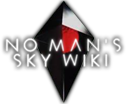| The subject of this article is from the Origins update.
The information from this article is up-to-date as of 9 November, 2020. |
The information from this article is up-to-date as of 9 November, 2020.
| This article was documented by the Galactic Hub. |
| Chrima E16 | |
|---|---|

| |
| Galaxy | Euclid |
| Region | Uefert Nebula |
| Star system | HUB6-1B Bab-Ilu |
| Moon(s) | Waluigi |
| Atmosphere | 56% Thamium9, 21% Nitrogen, trace others |
| Biome | Lush - Paradise |
| Weather | Mellow |
| Resources | Sb, Cu, Pf, Ag |
| Sentinels | Infrequent (Normal) Require Orthodoxy (Survival and Permadeath) |
| Flora | Few |
| Fauna | Ample (12) |
| Garden world | Yes |
| Claimed by | Galactic Hub Project |
| Discovered by | Nobody |
| Discovery platform | PC |
| Updated | Origins |
Chrima E16 is a planet in No Man's Sky.
Summary[ | ]
Chrima E16 is a planet in the HUB6-1B Bab-Ilu star system in the No Man's Sky universe.
As of October 31, 2020, this planet has been selected as the new capital planet of the Galactic Hub Project. Chrima E16 is a paradise planet, with incredibly earthlike conditions, no storms, infrequent Sentinel presence and lack of aggressive fauna.
Alias names[ | ]
| Original: | Chrima E16 |
|---|
| Current: | Drogradur NO426 |
|---|
| PC | Legacy | Chrima E16 |
|---|
Discovered[ | ]
- PC version - discovered and uploaded by PC explorer Nobody
- Explored and documented by GHGS Researchers FatherNestor and Dima
Planet type[ | ]
Biome - Lush - Paradise (Normal)
Biome - Lush - Grassy (Survival and Permadeath)
Moons[ | ]
This planet's moon is Waluigi.
Location[ | ]
It can be found in the HUB6-1B Bab-Ilu star system in the Uefert Nebula region of the Galactic Hub Project, in the Euclid galaxy.
Coordinates[ | ]
Glyphs[ | ]
501BF9557C30501BF9557C30
Notable locations / Waypoints[ | ]
Life[ | ]
Fauna[ | ]
- There are 12 fauna on this planet
| IMAGE | NAME | ECOSYSTEM | GENUS | HEIGHT | WEIGHT | DISCOVERED BY |
|---|---|---|---|---|---|---|
 |
O. Sweetdatusawae | Rare / Ground / Always Active |
Rangifae | 6.5m | 295.7kg | Halbatross |
 |
D. Formiauzea | Uncommon / Flying / Diurnal |
Agnelis | 1.2m | 65.6kg | Halbatross |
 |
P. Starersum | Uncommon / Flying / Always Active |
Agnelis | 1.7m | 85.6kg | Halbatross |
 |
V. Larvaokdetera | Rare / Flying / Mostly Diurnal |
Cycromys | 3.7m | 169.8kg | Halbatross |
 |
E. Beetekia | Rare / Ground / Always Active |
Felihex | 4.1m | 205.5kg | Halbatross |
 |
R. Ptyerrocoadus | Uncommon / Ground / Always Active |
Procavya | 1.5m | 84.5kg | Halbatross |
 |
D. Helaauraria | Rare / Ground / Always Active / Found in the North |
Prionace | 2.4m | 135.1kg | Phaedrus29 |
 |
I. Traseffis | Common / Underwater / Always Active |
Ictaloris | 0.3m | 59.7kg | Halbatross |
 |
Y. Seedtuyushima | Rare / Ground / Always Active |
Felidae | 1.8m | 109.1kg | Halbatross |
 |
V. Formirebea | Common / Underwater / Always Active |
Ictaloris | 1.0m | 76.3kg | Halbatross |
 |
C. Necknedfalum | Common / Ground / Mostly Diurnal |
Tetraceris | 0.7m | 41.2kg | Halbatross |
 |
Z. Aipprezenus | Common / Underwater / Always Active |
Ictaloris | 1.1m | 49.2kg | Halbatross |
Flora[ | ]
| IMAGE | NAME | ELEMENTS | AGE | ROOT STRUCTURE | NUTRIENT SOURCE | NOTES | DISCOVERED BY |
|---|
Minerals[ | ]
| IMAGE | NAME | ELEMENTS | METAL CONTENT | FORMATION PROCESS | NOTES | DISCOVERED BY |
|---|
Sentinels[ | ]
- In Normal Mode, the sentinels are Infrequent on this planet and don't present an immediate threat.
- In Survival and Permadeath Modes, the sentinels Require Orthodoxy on this planet and don't present an immediate threat.
Resources[ | ]
The following resources can be found on this planet, in form of mineral deposits/harvestable plants:




